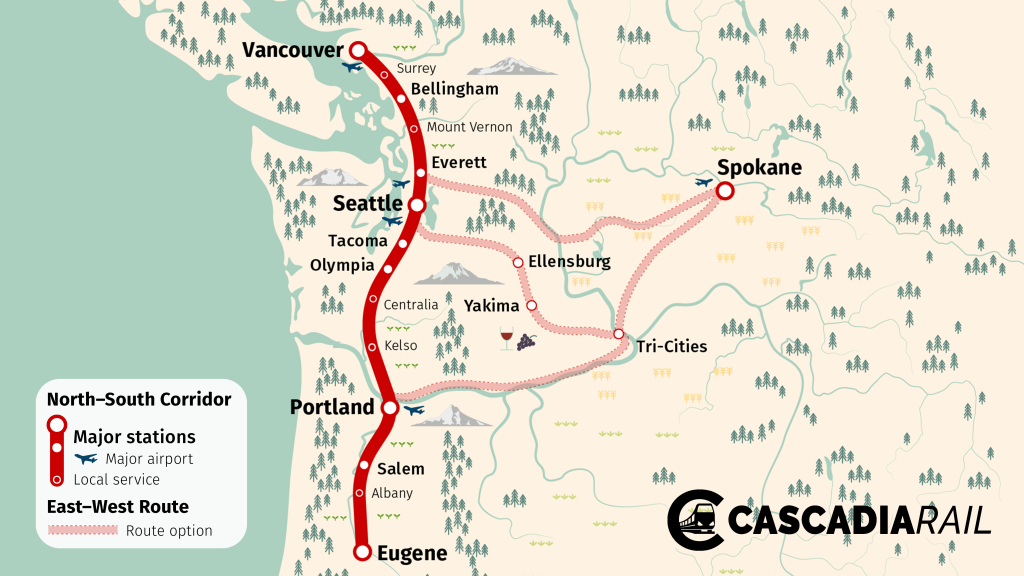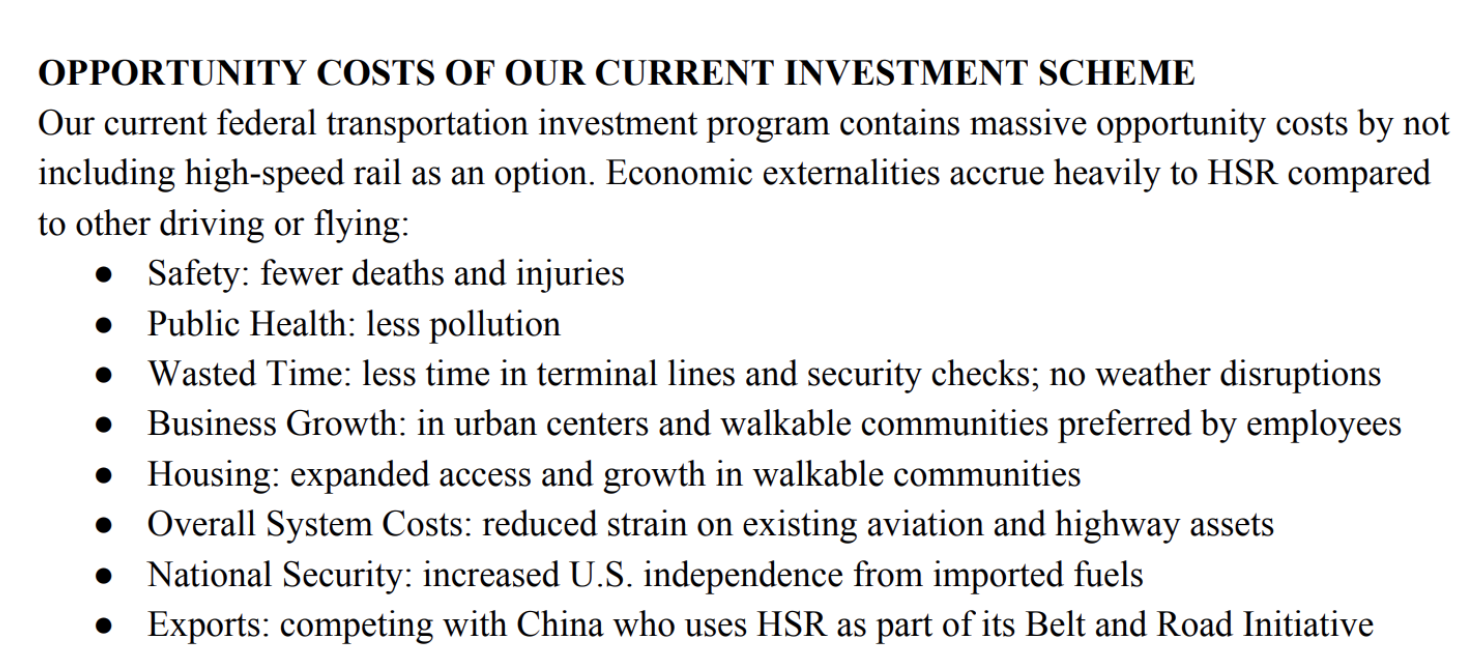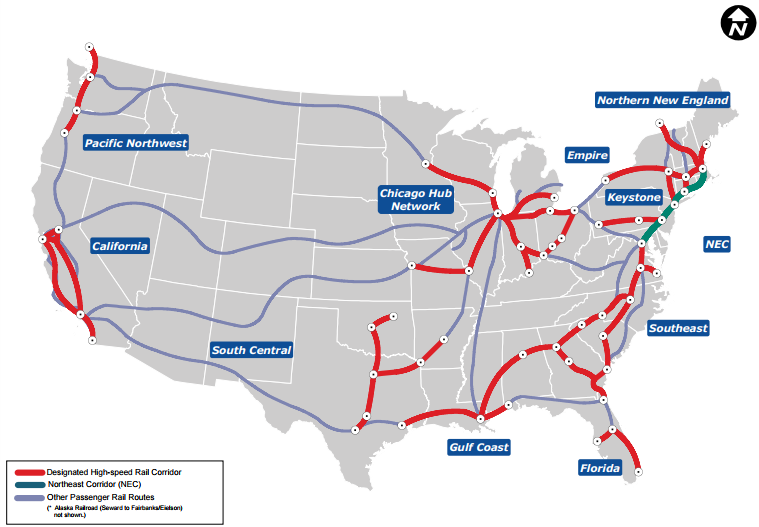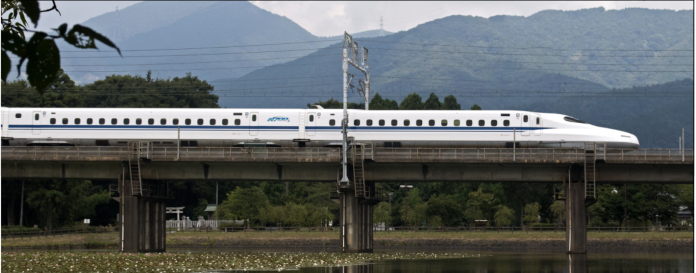A bill to fund the rollout of high-speed rail across America was recently introduced in the House of Representatives. The proposed policies would get the economy back on track by investing $205 billion over five years, creating jobs, competition in transportation, and giving Americans cleaner, faster, more reliable commutes. Join Cascadia Rail’s letter writing campaign and take two minutes to tell your elected officials to support the bill.
Representative Seth Moulton (D-Massachusetts) authored the bill and released a white paper on funding the rollout of National High Speed Rail, a bold vision for economic recovery as Americans look to get back to work. His proposal melds the economic recovery successes of Works Progress Administration, which employed more than 8.5 million out-of-work Americans who built 650,000 miles of highways and roads following the Great Depression, and President Eisenhower’s Federal Aid Highway Act, which led to the construction and funding of our Interstate Highway System.
As legislators look for solutions to remedy the economic hardship resulting from the Covid-19 pandemic, Moulton said the time is right for a robust plan to expedite high-speed rail. Over five years, fast trains would be funded in our country’s megaregions, connecting clusters of dense cities within 750 miles of each other.
Job Creation
Moulton’s proposal would create up to 1.16 million jobs annually for the 34 projects identified throughout the United States. In Texas, where Texas Central Railway (TCR) is building a high-speed rail system between Houston and Dallas, expected job creation nears 41,000. In the Pacific Northwest, 200,000 jobs will be created with the Cascadia High Speed Rail project. In addition to skilled labor needed for construction, operations, and maintenance, transit-oriented development will bring employment opportunities in other sectors. According to Moulton’s proposal, “for every direct job in the railway supply sector, 4.2 jobs are supported in other industries,” which would create positions for another 4.87 million people.

Good for Business
High-speed rail is a bipartisan win for both Democrats seeking new infrastructure and Republicans seeking private sector investment. Moulton’s bill includes incentives for an additional $38 billion in investments from the business community, such as lifting the cap on private activity bonds from $15 billion to $30 billion. Microsoft’s investment in the Cascadia project was highlighted as one of the partnership models.
Private entities, from tech companies like Microsoft to railway operators like Virgin Trains USA, have already begun planning and preparing to develop HSR corridors because of the broad economic gains brought to the firms directly and indirectly served by these lines. Energy suppliers and utility companies will also gladly meet the demand for electrified rail.
Additionally, 212 companies in 32 states manufacture passenger rail cars or components creating many jobs in communities even where rail construction would not occur.
Moulton explains that project investment could very feasibly grow to $48.6 billion with, “incentivized state and local government participation through transit-oriented development grants along high-speed rail corridors, increased flexibility regarding the non-federal share of high-speed rail planning and development costs, and the benefit of greater funding predictability for projects requiring multi-year federal investments.”
In the Pacific Northwest, Microsoft has shown continued support for the Cascadia high-speed rail line, pitching in nearly $600,000 to complete feasibility studies for the project led by the Washington State Department of Transportation (WSDOT).

Moulton’s proposal calls for public-private partnerships, with at least 20% of funds coming from private, non-federal sources. Private corporations would benefit from regional high-speed rail lines, as they could easily expand their workforce pool and their scope of influence, rising in international distinction. Further, local and regional transportation agencies would benefit from access to federal grants and program development.

Increase Global Competitiveness
Moulton explains how America’s dated transportation infrastructure is lagging behind the technological advances used by global competitors.
“[High-speed rail] best supports 21st-century development in bustling urban centers, walkable downtowns even in much smaller cities and towns, and the agglomeration economies of cities and megaregions that are driving the vast majority of current economic growth,” Moulton wrote.

With rapidly expanding networks in 20 countries throughout Europe and Asia and over 50 years of successful operation worldwide, high speed rail is no longer a futuristic goal; it is practical transportation that can serve the growing population of our large urban centers.
Moulton stated that a more reliable, efficient, faster transportation option between large, innovative cities is imperative for supporting a growing workforce and managing affordability of housing. As urban centers become more and more popular for people to live in, housing prices in the city spike and the city suburbs grow and sprawl. Gridlocked traffic creates travel times of 90 minutes or more for workers to commute from nearby towns. A high-speed rail system would reduce travel times of intercity commutes, improving productivity and allowing people to spend more time with their families instead of stuck in traffic.
In the Pacific Northwest, high-speed rail can transform these commutes:
- One hour from Seattle to Portland (currently three hours);
- One hour from Seattle to Vancouver, British Coumbia (currently three to four hours);
- Fifteen minutes from Seattle to Tacoma (currently 90 minutes at peak traffic); and
- Fifteen minutes from Seattle to Everett (currently 90 minutes at peak traffic).
Rail: A Smart Investment
Studies show that investing in highway projects, such as adding new lanes, quickly lead directly back to the root of the problem: traffic congestion. Investing in high-speed rail costs less than expanding highway infrastructure, creates good paying jobs for skilled labor, and yields higher returns on investment, in addition to providing a sustainable solution to gridlocked freeways.
The Cascadia High Speed Rail project would bring an 8:1 return on investment. Construction is estimated to cost between $24 billion to $42 billion, creating $355 billion in economic growth. In comparison, adding one lane to I-5 along the same corridor would cost $108 billion, take just as long to complete, and those lanes would be full by the time it opened.
In a presentation at the 2019 USHSR Cascadia Rail Summit, WSDOT Secretary Roger Millar compared the cost of highway expansion to investing in high-speed rail investment.
“It would cost $108 billion to add one lane in each direction on I-5, it would take just as long to build as high-speed rail, and by the time we open it, those lanes would likely be full,” Millar said. “Highway expansion cannot and will not keep up with growth, but we can make investments that can be gamechangers, like high-speed rail.”
A Free Market for Transportation Options
When given a choice of other transportation options, many people have shown preference to riding a train. Metrolink, a commuter passenger rail in Los Angeles, reported that 85% of their ridership chose to use the service despite owning a car. Their reasons for doing so mirror the preferences of the Millennial generation: “less stress, greater relaxation, less expensive, more efficient use of time, and environmental reasons.” What the United States needs, according to Moulton, is a true free market for transportation options.
People can choose to drive if they have access to a car, they can choose to fly if they have the means, or they can use public transit. If high-speed rail is posed as a regional transportation option, people will choose to ride it. High-speed rail in our nation’s megaregions will:
- Reduce traffic congestion around urban centers;
- Absorb airplane trips shorter than 750 miles, which are less profitable for airlines and have higher carbon emissions than long distance flights; and
- Improve profitability of airlines by freeing up airport gates for long distance flights of 750 miles or more.
Moulton concludes the white paper by highlighting 34 high-speed rail projects designated by the American Public Transportation Association, all in different stages of project planning.
Good jobs, good for business, and good for global competitiveness. It’s time to include funding high-speed rail projects in the United States as part of the economic recovery. Please join our letter writing campaign in support of this bill and send an email to your elected officials.



